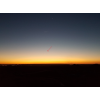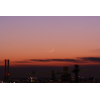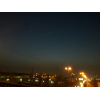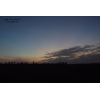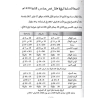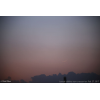Visibility of Jumadal Al-Aakherah Crescent 1438 AH
- When to Observe Jumadal Al-Aakherah Waxing (NEW) Crescent ?
- Jumadal Al-Aakherah Waxing (NEW) Crescent Observation Results
- The OFFICIAL First Day in Different Countries
- When to Observe Jumadal Al-Aula Waning (OLD) Crescent ?
- Jumadal Al-Aula Waning (OLD) Crescent Observation Results
When to Observe Jumadal Al-Aakherah Waxing (NEW) Crescent ?
The geocentric conjunction (Geocentric New Moon) will occur Inshalla on (Sunday 26 February 2017) at 14:58 UT.
Sighting the new crescent on (Sunday 26 February 2017) and (Monday 27 February 2017) is shown in the below graphs using the program Accurate Times by Mohammad Odeh according to Odeh criterion. Where:-
- It is impossible to see the crescent from the areas located under the red color. Because either the Moon on this day sets before the Sunset and/or the topocentric conjunction occurs after the Sunset.
- The crescent is expected to be seen by optical aid only from the areas located under the blue color.
- The crescent is expected to be seen by optical aid from the areas located under the magenta color. In these areas the crescent could be seen by naked eye if the atmospheric conditions are superb and the observer is experienced.
- The crescent is expected to be easily visible by naked eye from the areas located under the green color.
- The crescent cannot be seen from uncolored areas, even though the Moon sets in these locations after the Sunset and the topocentric conjunction occurs before the Sunset, but the Moon is not sufficiently illuminated in order to be seen as crescent even by optical aid.
- Kindly notice that the below graph shows the possibility of seeing the crescent from areas between 60 degrees north of Equator down to 60 degrees south of Equator.


According to the Universal Hejric Calendar (UHC), which is based on the calculated crescent visibility, the start of this month in the Eastern Region will be on Tuesday 28 February 2017 and in the Western Region will be on Tuesday 28 February 2017. Kindly notice that the UHC is a pre-calculated calendar, which adopts a certain criterion to start the new Hejric month. Your country/organization might adopt different criterion to start the new Hejric month. So it is highly advised to read the UHC website before giving any judgment.
- Results of seeing the crescent, and the first day of the month in different countries will be added here Inshalla as we receive the reports from ICOP's members. If you wish to be a member in ICOP, or to know more about it, kindly click here.
Jumadal Al-Aakherah Waxing (NEW) Crescent Observation Results
Sun 26 February 2017
Libya
Nigeria
Mr. Yunusa Yakubu said: "I observed a partial Solar Eclipse visible to all and sundry at sunset"
Mon 27 February 2017
Algeria
Germany
Eng. Martin Elsaesser said: "The young crescent was a very beautiful sight in good weather conditions. It was visible to the naked eye. I sat on the roof of our city observatory for half an hour and watched it go lower and lower till it vanished behind some clouds. I even made a video of this: https://www.youtube.com/watch?v=3ep3V9qU2t8 "
Indonesia
Mr. AR Sugeng Riyadi said: "The new crescent of Jumadal Akhirah 1438 AH was not seen on Monday, 27 Feb 2017 from Rowasiya Observatory at Bendo Ketitang Juwiring Klaten Central Java Indonesia, the sky was totally cloudy and rainy."
Iran
Mr. Hossein Janghorbani said: "In the name of God Jumadal Al-Aakherah Crescent Observation Report Astronomy and Geophysics Center of Shahreza – The Crescent Association of Shahreza Report by: Hossein Janghorbani (Najmosepehr-Sadrolmonajjemin) – Manager of Shahreza Crescent Association and Red Crescent’s Astronomy and Geophysics Center Date: Monday, 02/27/2017 Location: Damzad foothills in the East of Shahreza (latitude: 32 00 N, longitude: 51 52 E, elevation: 1825m from sea level, time zone: +3.5 GMT) Equipments: Two sets of 15*70 binoculars, One sets of 20*90 binoculars, One sets of 7*50 binoculars, One compass. Atmospheric condition: partly cloudy and Hazy in western horizon. Horizon obstacles: 1/5° Apparent sunset: 17:50 Results: Moon crescent was seen by 15*70 binoculars and 20*90 binoculars by Roya Ghermezi and Ali Janghorbani at 18:15, for the first time. Other group members observed crescent by binoculars subsequently. Crescent observed by Roya Ghrmezi at 18:19 by naked eye. Other group members observed crescent by naked eye. Mr.Reza Janghorbani based in the city of Tabriz in East Azerbaijan province Moon Crescent At 18:29 is observed with the naked eye. Observers: 1.Dr Ali Akbar Taki 2.Mahdi Ghasemi 3.Ali Janghorbani 4.Hossein Janghorbani 5.Ziba Hafar 6.Nazanin Piroozmandan 7.Tayebeh Shafiee 8.Zinat Ghermezi 9.Roya Ghermezi 10.Zahra Fallahi 11. Reza Janghorbani based in the city of Tabriz in East Azerbaijan province "
Morocco
Dr. Hassan Talibi said: "أثناء كتابة هذا التقرير أعلنت وزارة الأوقاف عن رؤية الهلال وبذلك يكون فاتح جمادى الآخرة هو غدا الثلاثاء 28 فبراير. وكذلك كانت توقعات الحسابات كما توضح الوثيقة المرفقة. "
Saudi Arabia
Mr. Turki Alamri said: "The new crescent was so so difficult to see by naked eye due to bad sky but i managed to see it ."
South Africa
Dr. Abdurrazak Ebrahim said: "The first day of Jamadith Thani will be on Wednesday, 1 March 2017 in Southern Africa"
Sri Lanka
Mr. Abdul Rahman Razeen said: "Aalaikum. Today 27-02-2017CE=29-05-1438AH is the sighting day for the month of Jumadassaniyah 1438AH. I was in Galle fort.I was asked to come to Galle by Maulana Mazeen Al-Makhdoomy who conducted a workshop for the ulamaa's of the higher grades in Arabic madrasas in Galle for 3 days related to astronomy. First 2 days the workshop was done showing the method of calculating prayer times and defining the direction of Qiblah. The last day which was today it was about discussing about the method of sighting the hilaal.We were altogether 40 brothers most of them are students. We had 2 kinds of telescope one was a protocol and the other one was 2x Barlow which was brought by Maulana Mazeen Al-Makhdoomy and the setup was done by Bro.Nular Baary who is a Satellite Eng. We were all their 40 minutes before the Sunset.The horizon was cloudy. The parameters are(at Galle) Sun set:6:23pm. Moon set:7:08pm. Lag=45minutes The prediction of the astronomers=Crescent can be sighted if the atmosphere was clear and the observer is an experienced sighter. Hilaal sighting groups was arranged right round the country.We couldn't sight the crescent and the CGM Hilal Committee had received negative sighting reports from the other groups. Hence it was decided by the CGMH Committee which was presided by Moulana Riyadh (Baari) along with ACJU and MRCA to complete the proceeding month as 30 days and start the month of Jumadassaniyah on 1-3-2017CE."
Tanzania
Mr. Zaffar Sheriff said: "Very cloudy conditions. Crescent was not sighted."
United Kingdom
Eng. Qamar Uddin said: "On Monday 27 February 2017, the Hilal of Jumada Al-Ukhra 1438 AH was not seen in York (UK) as it was totally cloudy and raining. However, it was easily seen at two other places (London and Preston) by our ICOUK members. More details available on icouk.net website with photos/videos."
United States
Dr. Javad Torabinejad said: "I arrived at my sighting location (Blacksburg Middle School) at 6:39 pm EST (sunset: 6:14 pm) and left there at 6:47 pm (moonset: 7:34 pm). "
The OFFICIAL First Day in Different Countries
Tue 28 February 2017
1 . Indonesia
2 . Iran
3 . Morocco
4 . Nigeria
When to Observe Jumadal Al-Aula Waning (OLD) Crescent ?
The geocentric conjunction (Geocentric New Moon) will occur Inshalla on (Sunday 26 February 2017) at 14:58 UT.
Sighting the OLD crescent on (Sunday 26 February 2017) and (Saturday 25 February 2017) is shown in the below graphs using the program Accurate Times by Mohammad Odeh according to Odeh criterion. Where:-
- It is impossible to see the OLD crescent from the areas located under the red color. Because either the Moon on this day rises after the Sunrise and/or the topocentric conjunction occurs before the Sunrise.
- The crescent is expected to be seen by optical aid only from the areas located under the blue color.
- The crescent is expected to be seen by optical aid from the areas located under the magenta color. In these areas the crescent could be seen by naked eye if the atmospheric conditions are superb and the observer is experienced.
- The crescent is expected to be easily visible by naked eye from the areas located under the green color.
- The crescent cannot be seen from uncolored areas, even though the Moon rises in these locations before the Sunrise and the topocentric conjunction occurs after the Sunrise, but the Moon is not sufficiently illuminated in order to be seen as crescent even by optical aid.
- Kindly notice that the below graph shows the possibility of seeing the crescent from areas between 60 degrees north of Equator down to 60 degrees south of Equator.
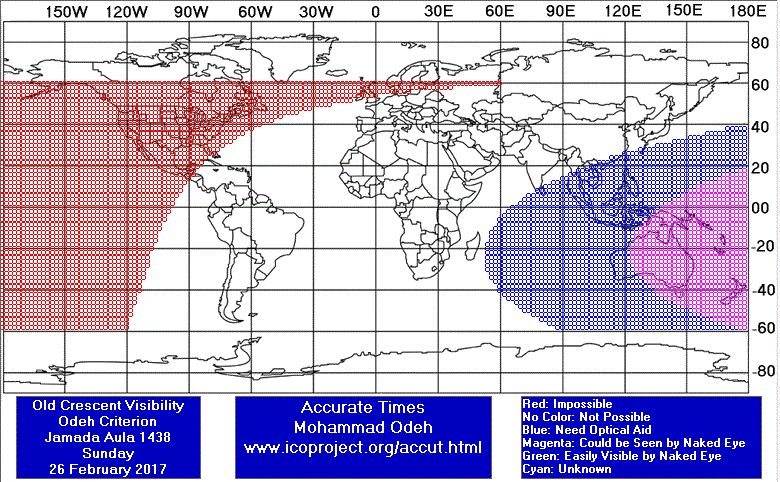
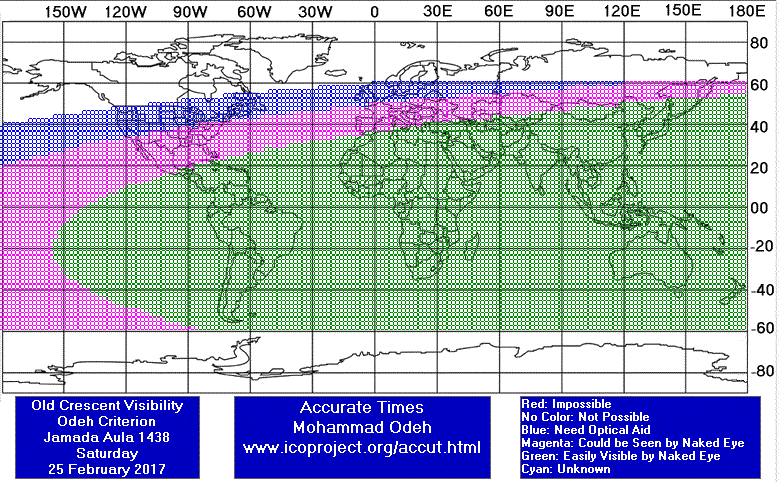
Jumadal Al-Aula Waning (OLD) Crescent Observation Results
Sat 25 February 2017
Germany
Eng. Martin Elsaesser said: "A cloudbank in the east prevented an sighting soon after moonrise but after the crescent had risen above that it could be seen with binoculars. I could not see it with the naked eye."
Indonesia
Mr. AR Sugeng Riyadi said: "The old crescent of Jumadal Ula 1438 AH was not seen on Saturday, 25 Feb 2017 from Rowasiya Observatory at Bendo Ketitang Juwiring Klaten Central Java Indonesia, the sky was totally cloudy."
